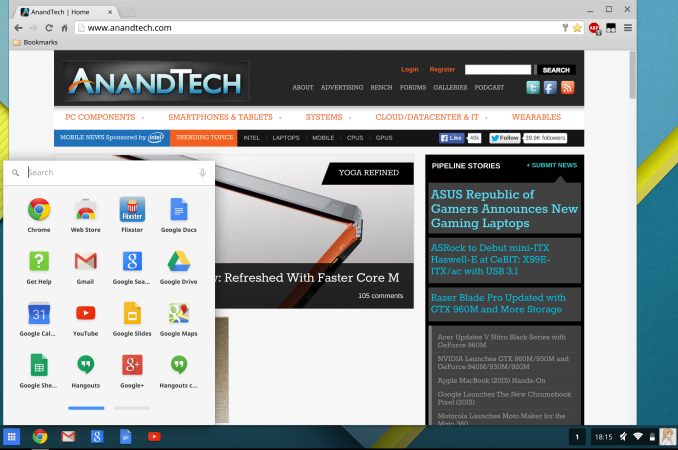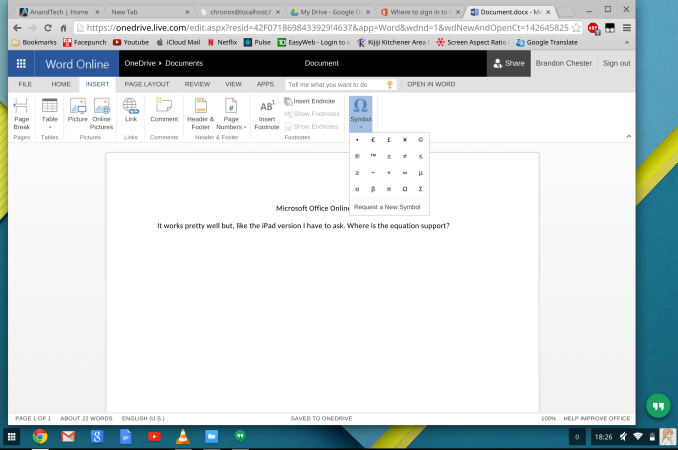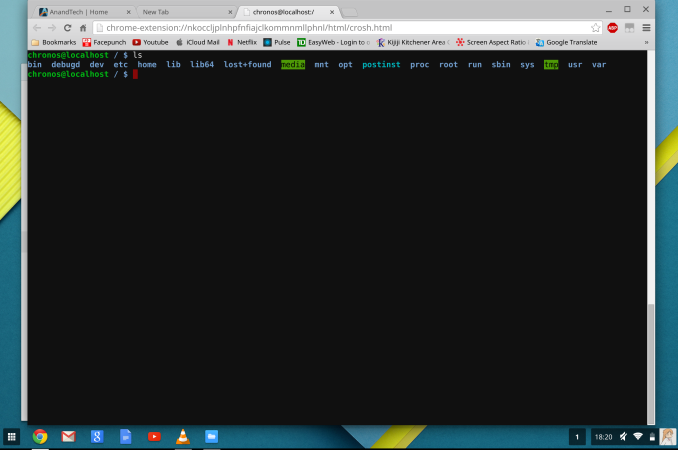The Chromebook Pixel (2015) Review
by Brandon Chester on March 16, 2015 8:00 AM EST- Posted in
- Laptops
- Chrome OS
- Chromebook
- Chromebook Pixel
Software
To tell the truth, I hadn't had much experience with Chrome OS before using the Chromebook Pixel. Years ago I installed Chromium OS to see what it was like, but I quickly wrote it off as far too limited to perform the tasks that I do on a daily basis. Since then, web applications have improved immensely, and Chrome OS itself has had new applications added and changes made to the interface to make it feel more like a typical operating system. But at its heart, it's still just Chrome and web apps, and so it was interesting to see what could be done within those bounds.
When you first get your Chromebook you'll be asked to log into your Google account. From that point, you're sent right to what could be called the home screen for Chrome OS. At the bottom you have a shortcut to Chrome, along with shortcuts to other Google products like Docs and Gmail which are actually just links to the website for each respective product. However, not all Chrome OS applications run within Chrome. There's a Calculator application which greatly resembles the Android Lollipop calculator, and a Files application to view your removable storage and downloads in addition to showing your files stored in Google Drive.
At this point you're basically ready to go. There aren't many settings to change or any applications to configure once you've signed in with your Google account. In fact, if you're already invested in Google's ecosystem you'll be able to start editing your Google Docs files and access your Google Drive immediately. I do use Google drive, but I use Microsoft Office instead of Google Docs, Sheets, and Slides for editing documents which could pose a problem. Luckily, Office has moved to the cloud and so users who don't edit their documents using Google's software aren't left out in the cold.
Unfortunately, many cloud counterparts to desktop software are missing important features. In the case of Office, you lose many formatting tools, including the ability to insert equations which is a tool I use frequently. Charts and text boxes are also removed in the cloud version of Word. I understand the need to simplify these applications when they're being run in a web browser, but it doesn't change the fact that many tools users expect to be there are missing.
How Google's office application handle files can also be somewhat problematic. I'm sure most people have been sent a file in one of Microsoft's Office formats at some point in their lives. Google claims somewhere around 90% feature compatibility with Microsoft Office files. On one hand, this is pretty impressive for software that runs in a web browser. But on the other hand, when you only have 90% feature compatibility, you're basically completely incompatible with every file that uses any feature from that last ten percent. Importing a PowerPoint file to Google Slides will cause objects like charts to just be completely erased, and I would hardly consider the use of charts in PowerPoint presentations to be uncommon.
For media playback, the default video and music applications are more than sufficient for most users. Google even has support for the Matroska container which is more than can be said for other operating systems. For playing back less common file types, or videos with subtitles, the built in players aren't quite up to the task. Luckily, the Android version of VLC is slated to come to Chrome OS in the near future via the App Runtime for Chrome. Google was able to provide me with a debug version to see how well it worked. It definitely needs some polish, but there's still quite some time between now and release, and I don't know how up to date the debug build I'm using is.
Overall, I think that Chrome OS still does a pretty good job of handling files that come from a Windows PC world. There's still work to be done though, and anybody who's considering the Pixel or any other Chromebook should understand what they're getting into.
For users who want to play around with the underlying Linux core of Chrome OS, there's a fully functional shell which is accessible via Chrome after putting the laptop into developer mode. This allows you to access more of the file system, and you can even install versions of Ubuntu or Debian using Crouton. Obviously I can't recommend doing so due to the potential security and stability risks, but the options are available for any users who are interested. The Chrome OS shell already has the ability to connect to another computer via SSH once developer mode is enabled, and it opens up a whole new world of possibilities for the Pixel.
I'm definitely more open to using Chrome OS than I was when the original Pixel launched. I know that many users would be able to do everything they currently do on Windows with a Chromebook. However, those users aren't likely to be the ones who are looking for a $1000 laptop. For me personally, Chrome OS is still too limited, and it will probably always be too limited for me to use as a primary operating system. But it's an interesting idea, and with Google working with developers to get Android applications brought over to Chrome OS there's no telling what the state of Chrome OS will be by the time a Pixel v3 rolls around.














123 Comments
View All Comments
Brandon Chester - Monday, March 16, 2015 - link
The issues with benchmarking it against other laptops are explained on the CPU performance page.MantasPakenas - Monday, March 16, 2015 - link
What I meant is that I don't see how those are issues. The issue that there are very few benchmarks you can run on a Chromebook? Yeah, sure. But where is the issue of including data points you already have for other laptops for these same benchmarks? E.g. here:http://www.anandtech.com/bench/Notebook/729
You also have charging times of normal laptops, as well as browsing and video playback battery life. Why not include those? I really don't see how comparing this to an iPad makes any more sense.
JarredWalton - Monday, March 16, 2015 - link
The "Light" and "Heavy" laptop tests are completely different than what we run on Chomebooks. The Light test uses IE10/11, cycling through a set of four open tabs. We could probably do this on a Chromebook, though we would need to modify it to make it work comparably (as the Windows Light test actually runs from a batch file).The Heavy test is a different matter. We're playing a 1080p video fullscreen, surfing the web with four pages loading every ~7 seconds, and downloading over FTP at 8Mbps. Without a good FTP client, this is pretty much impossible to do on a Chromebook. Plus on every other Chromebook other than the Pixel (and maybe the Core i3 Acer models) you won't be able to do all of these tasks without the video stuttering.
Bottom line is that most Chromebooks have hardware and pricing that's similar to tablets, so we use the tablet benchmarks for comparison.
MantasPakenas - Tuesday, March 17, 2015 - link
If I understand correctly, you're saying that it would be possible to benchmark the Pixel against it's real competition, but since most of the Chromebooks are underpowered, you are putting this monster up against much weaker devices. This still doesn't make sense to me. HP Stream 11 costs, performs and competes against Chromebooks, yet you measure it mostly against high end laptops (although C720 is included in some applicable benchmarks, and even an iPad Air in charging times). I question that approach as much as this case.Just as much as it makes sense to benchmark SSDs against other SSDs, low end phones against other low end phones, high end ones against iPhone 6 and tablets, it makes sense to benchmark the Pixel against high end laptops, because it deserves that treatment. Nobody is any wiser to know it can beat all tablets and budget chromebooks.
And I bet it wouldn't stutter playing a video, downloading and surfing the web at the same time. Yet I'm doing all those things concurrently on my HP Chromebook 14, and you bet I would do it on the Pixel!
jabber - Wednesday, March 18, 2015 - link
Indeed, I've seen plenty people pay $1200+ for a Macbook/Mac just to look at Facebook/Amazon because they didn't want to deal with Windows anymore.mekpro - Monday, March 16, 2015 - link
Nice review and really fast !I wish there are more extensive tests for USB Type-C, as this is the very first laptop to ship with it. I wonder what is the maximum resolution and how many external display supported ? Is the limitation come from the USB Type-C or Broadwell or the ChromeOS itself ?
Dumbledore147 - Monday, March 16, 2015 - link
Me too. I would love to see a setup with two 4k monitors running at 60 Hz while charging the chromebook.psychobriggsy - Monday, March 16, 2015 - link
The device, like the new MacBook, supports USB 3.1 Rev 1, otherwise known as USB 3.0 (i.e., 5 Gbps) on a USB Type C port (which adds charging, displayport, USB 2.0).We'll have to wait until Broadwell supports USB 3.1 Rev 2 for 10 Gbps data transfers.
tyger11 - Monday, March 16, 2015 - link
Type-C is a connector. The underlying port itself is a standard 5gbps USB 3.0 port. It's unfortunate they didn't go with USB 3.1, but neither did the new Apple MacBook Retina (even though they're calling it 'USB 3.1 Gen 1'. Ugh.JBVertexx - Monday, March 16, 2015 - link
This is a very targeted strike directly at the MacBook pro. The current market is very small, as many have commented on. I think an equally likely user is an account executive for companies that use the Google ecosystem.My company (a pre-IPO enterprise software company) uses the entire Google ecosystem. So, when I am traveling, I use either Gmail, Google docs, or some other web-based application for nearly 100% of my use. The percentage of time that I need to actually use MS Office is getting smaller and smaller.
When you compare this against the new 13-inch MacBook pro, the specs compare very favorably. The Pixel has a stronger processor (the 13" MacBook pro only ships with an i5), but the Pixel has much less storage space, clearly catering to cloud users (100% of what I store is in the cloud).
Google may be giving these away to developers, but I don't think that is the target audience for this. There is a small sliver of working professionals who will buy this over a MacBook pro. Google is using that niche market to improve the product, improve Chrome OS, and will over the next couple years be well positioned to be a serious competitor.